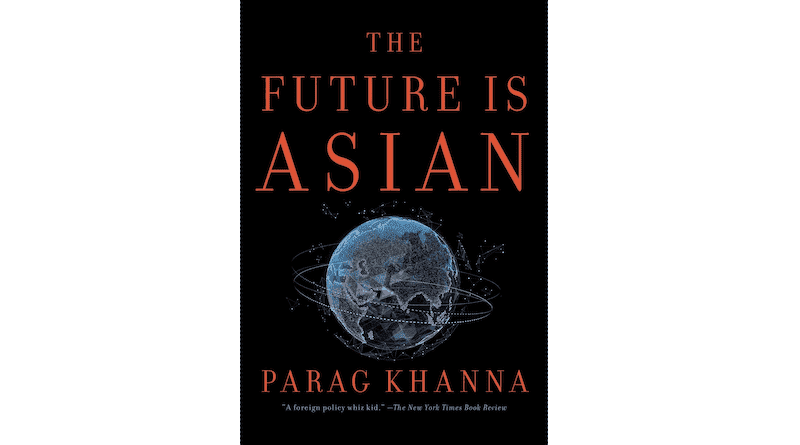The Future Is Asian: Commerce, Conflict And Culture In The 21st Century – Book Review
By Adam Arthur
The thesis of Parag Khanna’s The Future is Asian is fairly obvious based on the title. Namely, Khanna predicts that Asian influence will come to dominate the 21st century, supplanting western influence. To support this conclusion, Khanna posits that, while the United States and Europe are distracted by internal political and economic turmoil, Asian powers will combine multilaterally and strengthen the region through international cooperation, potentially under the type of technocratic leadership that Khanna has built his career on advocating. Though many points are interesting and thought-provoking, Khanna’s arguments also contradict themselves at a number of key junctures.
Khanna appears primarily interested in soft power including cultural exports as well as large-scale economic phenomena involving trade. A number of chapters touch on topics such as global media as well as Khanna’s political preference for technocratic governments based on the Singaporean model. However, there are also plenty of arguments in this volume that should pique the interest of Security Studies enthusiasts, either as a point to critically contest or as a basis for further research. Some of these are regional – such as the notion that Asian powers will exert broader influence in Latin America and Africa. These are fairly viable proposals backed up by such real-world evidence as China’s increased investment in these regions, in an attempt to serve as an economic “gateway” for parts of Africa, as well as Asian states’ increased trade with Latin American countries. However, the main weakness of the text lies in the key points that constitute Khanna’s more general arguments.
These key points include a broad definition of Asia as “more of a sponge than a bloc”. Per Khanna’s definition, Asia is an expansive region that includes the Middle East and Central Asia – a portion of the continent that Khanna refers to broadly as “Southwest Asia. Additionally, one of Khanna’s more provocative arguments is that the west (including the United States) is distracted by its “China-centric” rhetoric, to the point of ignoring Asia’s multilateral rise as a region. However, Khanna’s notion of a multilateral Asian future also ignores the deep civilizational divides that exist within his expansive concept of Asia.
Khanna’s observations in The Future is Asian often prove themselves provocative at the expense of ending up deeply flawed. For example, Khanna appears unsure whether “Southwest Asia” is a part of the broad vision of a pan-Asian multilateralism he articulates, or whether the Middle East and Central Asian states he remarks upon constitute a network of client states for East Asian powers. In other words, Khanna’s view of the gulf states in relation to Asia more broadly paints them less as equal trading partners than a dependent periphery to China’s core. This in turn undermines his argument of a broad Asian multilateralism that includes the middle east (or, more broadly, Southwest Asia).
Additionally, Khanna’s view of China’s role in the Middle East seems to contradict his point that the United States is overly concerned about Chinese ambitions in Asia. Khanna, for example, points out that the Gulf States of the Middle East are increasingly looking toward China as a trade partner and moving away from the United States. Rather than proving Khanna’s point, this would imply that the United States is right to be concerned about competition from China, and that China-centric geopolitical rhetoric in the west is far from unfounded.
Moreover, Khanna’s main thesis – that Asia will gain power and influence through cooperation between its multifarious states – finds itself contradicted by Khanna’s own observations. Khanna notes, for example, that the idea of Asia is largely a social construct established by European powers to designate a cultural “other” to its east. Reaffirming this point, Asia constitutes a broad range of national identities that have little in common, making shaky ground for any future of cooperation.
Although Khanna makes an argument for his case that involves historical interconnectivity going back to the original Silk Road, this basis for his argument proves fairly weak in the face of well-defined intercultural and civilizational differences across Asia. Khanna’s most questionable statement throughout his book is one that reaffirms his main thesis: that Asia’s leaders anticipate a “humble yet productive commonwealth of commerce and learning”.
The Future is Asian is a provocative work that should be of interest to businesspeople, journalists, geographers, economists, and world travelers, but also – to a lesser extent – to scholars and practitioners of global security. Many of Khanna’s points, taken individually, would serve as a good devil’s advocate exercise for a course on geopolitical analysis or forecasting. However, although the work is interesting and worthy of academic discussion, many of Khanna’s more controversial arguments prove themselves self-contradictory, with a foundation built on sand rather than stone.

